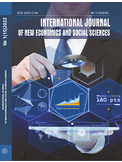THE DYNAMICS OF FEMALE LIFE EXPECTANCY AND TOTAL FERTILITY RATE IN BANGLADESH: A TIME-SERIES ANALYSIS
THE DYNAMICS OF FEMALE LIFE EXPECTANCY AND TOTAL FERTILITY RATE IN BANGLADESH: A TIME-SERIES ANALYSIS
Author(s): Zerin JannatSubject(s): Methodology and research technology, Evaluation research, Demography and human biology, Post-War period (1950 - 1989), Transformation Period (1990 - 2010), Present Times (2010 - today)
Published by: Międzynarodowy Instytut Innowacji "Nauka - Edukacja - Rozwój"
Keywords: Female life expectancy; total fertility rate; vector autoregressive (VAR) framework; Granger-causality test; impulse response function; Bangladesh;
Summary/Abstract: The association between female life expectancy and total fertility rate (TFR) is seldom explored and little understood. This study empirically explores the nature and dynamics of the relationship between female life expectancy and total fertility rate. Secondary data over the period 1973-2019 have been used from Bangladesh and obtained from the World Bank Dataset. Data have been analyzed using the vector autoregressive (VAR) framework that includes methods of inferences such as the Granger causality test and impulse response analysis. The association between female life expectancy and total fertility rate is negative for Bangladesh. The negative impact of total fertility rate on female life expectancy is statistically significant and prominent. A one standard deviation shock to total fertility rate can lead to a persistent decline in female life expectancy. On the contrary, the impact of female life expectancy of total fertility rate is observed to be of little magnitude. Greater attention needs to be paid to total fertility rate given the substantial impact it exerts on female life expectancy. In Bangladesh, total fertility rate has become static in recent years and a decline in use of all family planning methods has also been observed during the COVID-19 pandemic. This decline could exert shock on the total fertility rate and thus, lead to a persistent decline in female life expectancy. The findings of this study recommend that pragmatic approaches, such as regular recruitment and training of field-level workers to counsel women on FP methods, be adopted to enhance recovery of FP methods use and cushion the total fertility rate as well as female life expectancy from any shocks caused by decline in use of FP methods during the COVID-19 pandemic.
Journal: International Journal of New Economics and Social Sciences IJONESS
- Issue Year: 15/2022
- Issue No: 1
- Page Range: 9-20
- Page Count: 12
- Language: English

